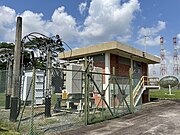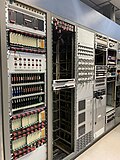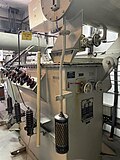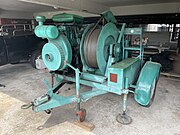
Shortwave radio is radio transmission using radio frequencies in the shortwave bands (SW). There is no official definition of the band range, but it always includes all of the high frequency band (HF), which extends from 3 to 30 MHz ; above the medium frequency band (MF), to the bottom of the VHF band.
International broadcasting, in a limited extent, began during World War I, when German and British stations broadcast press communiqués using Morse code. With the severing of Germany's undersea cables, the wireless telegraph station in Nauen was the country's sole means of long-distance communication.

In radio, longwave, long wave or long-wave, and commonly abbreviated LW, refers to parts of the radio spectrum with wavelengths longer than what was originally called the medium-wave broadcasting band. The term is historic, dating from the early 20th century, when the radio spectrum was considered to consist of longwave (LW), medium-wave (MW), and short-wave (SW) radio bands. Most modern radio systems and devices use wavelengths which would then have been considered 'ultra-short'.

Radio Netherlands was a public radio and television network based in Hilversum, producing and transmitting programmes for international audiences outside the Netherlands from 1947 to 2012.
The Sutton Coldfield transmitting station is a broadcasting and telecommunications facility located in Sutton Coldfield, Birmingham, England. In terms of population covered, it is the third most important transmitter in the UK, after Crystal Palace in London and Winter Hill near Bolton.

Rampisham Down is a chalk hill in the Dorset Downs, eight miles north west of Dorchester in west Dorset, England. The highest part of the hill is 221 metres (720 feet). To the north east of the hill is the Frome valley and the village of Rampisham, to the south west is the Hooke valley and the village of Hooke. The A356 road between Dorchester and Crewkerne cuts across the down.
Radio jamming is the deliberate blocking of or interference with wireless communications. In some cases, jammers work by the transmission of radio signals that disrupt telecommunications by decreasing the signal-to-noise ratio.
HCJB, "The Voice of the Andes", was the first radio station with daily programming in Ecuador and the first Christian missionary radio station in the world. The station was founded in 1931 by Clarence W. Jones, Reuben Larson, and D. Stuart Clark. HCJB now focuses on Ecuador with unified programming on FM at 89.3 MHz in Pichincha, at 92.5 MHz in Manabí, at 96.1 MHz in Tungurahua and Cotopaxi, at 98.3 MHz in Esmeraldas and with separate programming on AM at 690 kHz. Broadcasts in Spanish and indigenous languages on 6.05 MHz (1 kW), continue on an intermittent basis with a new solid state transmitter which in 2017 replaced an older (5 kW) transmitter. These broadcasts were not listed on the HCJB English website as of February 2016.
A broadcast transmitter is an electronic device which radiates radio waves modulated with information content intended to be received by the general public. Examples are a radio broadcasting transmitter which transmits audio (sound) to broadcast radio receivers (radios) owned by the public, or a television transmitter, which transmits moving images (video) to television receivers (televisions). The term often includes the antenna which radiates the radio waves, and the building and facilities associated with the transmitter. A broadcasting station consists of a broadcast transmitter along with the production studio which originates the broadcasts. Broadcast transmitters must be licensed by governments, and are restricted to specific frequencies and power levels. Each transmitter is assigned a unique identifier consisting of a string of letters and numbers called a callsign, which must be used in all broadcasts.

ALLISS is a somewhat rotatable antenna system for high power shortwave radio broadcasting in the 6 MHz to 26 MHz range. An ALLISS module is a self-contained shortwave relay station that is used for international broadcasting.

The Heilsberg transmitter was a large radio transmitting station operated by the Reichs-Rundfunk-Gesellschaft between 1930 and 1945 in the German Province of East Prussia. It was sited approximately 3 kilometres (1.9 mi) northwest of Lidzbark Warmiński, on the road to Bagrationovsk.

The Woofferton transmitting station is owned and operated by Encompass Digital Media, as one of the BBC's assets which were handed over as part of the privatization of World Service distribution and transmission in 1997. It is the last remaining UK shortwave broadcasting site, located at Woofferton, south of Ludlow, Shropshire, England. The large site spreads across into neighbouring Herefordshire.

Radio Ukraine International, abbreviated RUI, is the official international broadcasting station of Ukraine, with foreign language news and programming being produced by Ukrainian Radio's main editorial department for broadcasting in EBU languages. RUI broadcasts in Belarusian, Bulgarian, English, Hungarian, Polish, Romanian and Slovak. The Ukrainian language programming aired on RUI is produced by the domestic First Channel.

The Lisnagarvey transmitting station is a facility for mediumwave broadcasting located in the townland of Magherageery, on the southern edge of Lisburn, Northern Ireland. It is close to Sprucefield shopping centre and about one mile from the middle of Lisburn.
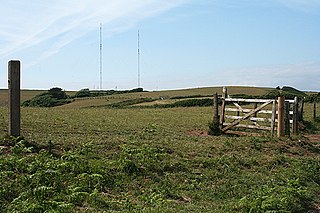
The Start Point transmitting station is a broadcasting facility at Start Point, Devon, owned by Arqiva. The site is just north-west of the Start Point lighthouse.
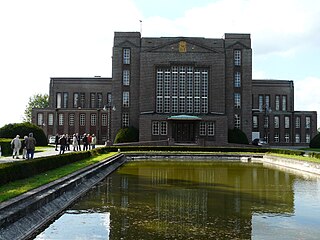
Nauen Transmitter Station in Nauen, Havelland district, Brandenburg, Germany, is the oldest continuously operating radio transmitting installation in the world. Germany's first high power radio transmitter, it was founded on 1 April 1906 by Telefunken corporation and operated as a longwave radiotelegraphy station through World War II, and during World War I became Germany's main link with the outside world when its submarine communications cables were cut. Upgraded with shortwave transmitters in the 1920s it was Germany's most advanced long range radio station, continually upgraded with the latest equipment and serving as an experimental station for Telefunken to test new technology. At the end of World War II, invading Russian troops dismantled and removed the transmitting equipment. During the Cold War it served as the GDR's international shortwave station Radio Berlin International (RBI), and was the East Bloc's second most powerful radio station, disseminating Communist propaganda to other countries. Since German Reunification in 1991 it has been operated by Deutsche Telekom, Germany's state telecommunication service. The original 1920 transmitter building designed by architect Herman Muthesius is still used; it is one of the many remaining buildings designed by that architect that is a protected cultural heritage site.

Shortwave relay stations are transmitter sites used by international broadcasters to extend their coverage to areas that cannot be reached easily from their home state. For example, the BBC operates an extensive net of relay stations.

CKCX was the call sign used for the Canadian Broadcasting Corporation's shortwave transmitter complex near Sackville, New Brunswick at the Tantramar Marshes. The Sackville Relay Station was operated by Radio Canada International and broadcast its programming around the world as well as relay transmissions from several foreign shortwave broadcasters. Domestically, it transmitted broadcasts on 9.625 MHz to northern Quebec by CBC North, the James Bay Cree Communications Society and Taqramiut Nipingat, the Inuit communications society of the Nunavik region of northern Quebec. The CKCX designation was assigned after CBC Radio's CBA, under whose licence the Sackville complex originally operated, moved to Moncton in 1968. Sackville was also used by Radio Japan, China Radio International, Voice of Vietnam, BBC World Service, Deutsche Welle and Radio Korea as part of a transmitter time exchange agreement.

The Leicester Peak transmitting station is a broadcast transmitting station and communications relay station located near Freetown, Sierra Leone. The site is owned by the Sierra Leone Broadcasting Corporation the country's state broadcaster. It is now the primary transmitting station providing broadcast services for the Western Area of Sierra Leone. Previously the SLBC operated a shortwave transmitting station in Waterloo and a shortwave/mediumwave station in Goderich.




